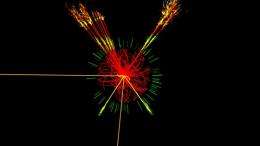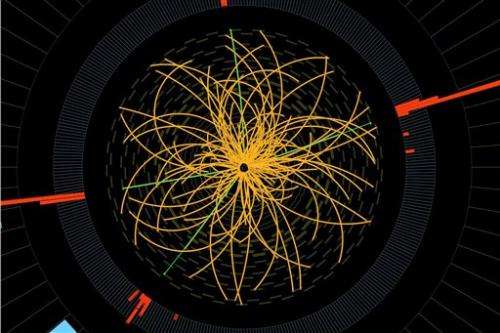Simulated production of a Higgs event in ATLAS. Image credit: CERN.
Physicists said Thursday they are now confident they have discovered a crucial subatomic particle known as a Higgs boson—a major discovery that will go a long ways toward helping them explain why the universe is the way it is.
It helps solve one of the most fundamental riddles of the universe: how the Big Bang created something out of nothing 13.7 billion years ago.
In what could go down as one of the great Eureka! moments in physics—and win somebody the Nobel Prize—scientists said Thursday that after a half-century quest, they are confident they have found a Higgs boson, the elusive subatomic speck sometimes called the "God particle."
The existence of the particle was theorized in 1964 by the British physicist Peter Higgs to explain why matter has mass. Scientists believe the particle acts like molasses or snow: When other tiny basic building blocks pass through it, they stick together, slow down and form atoms.
Scientists at CERN, the Geneva-based European Organization for Nuclear Research, announced in July that they had found something that looked like the Higgs boson, but they weren't certain, and they needed to go through the data and rule out the possibility it wasn't something else.
On Thursday, they said they believe they got it right.
"To me it is clear that we are dealing with a Higgs boson, though we still have a long way to go to know what kind of Higgs boson it is," said Joe Incandela, a physicist who heads one of the two main teams at CERN, each involving about 3,000 scientists.
Whether or not it was a Higgs boson had to be demonstrated by how it interacts with other particles and its quantum properties, CERN said. The data "strongly indicates that it is a Higgs boson," it said.
The discovery explains what once seemed unexplainable and still is a bit hard for the average person to comprehend. But it means the key theory that scientists use to explain everything works—for now, at least.
Its discovery could be a strong contender for the Nobel, though it is uncertain whether the prize would go to the 83-year-old Peter Higgs and the others who first proposed the theory, or to the thousands of scientists who found it, or to all of them.
Finding it wasn't easy. It took more than two decades, thousands of scientists and mountains of data from trillions of colliding protons.
And it needed the world's biggest atom smasher—CERN's Large Hadron Collider, which cost $10 billion to build and run in a 17-mile (27-kilometer) tunnel beneath the Swiss-French border—to produce the extreme surge of energies simulating those 1 trillionth to 2 trillionths of a second after the Big Bang.
The Higgs boson is so elusive that only about one collision per trillion will produce one of them in the collider.
CERN said it is open question whether this is the Higgs boson that was expected in the original formulation, or the lightest of several Higgses predicted in some theories that go beyond that model.
"We found a new particle and we want to know how it behaves, and maybe it behaves the way it was predicted in 1964, maybe it's a little bit different," said physicist Sean Carroll of the California Institute of Technology, who isn't involved in the research.
Finding a Higgs more or less as expected is actually a bit deflating, Carroll said, because physicists had also hoped that an unexpected type of Higgs might open windows into yet more mysteries of the universe.
"Scientists always want to be wrong in their theories. They always want to be surprised," he said. "It's a bittersweet victory when your theory turns out to be right, because it means, on the one hand, you're right, that's nice, but on the other hand, you haven't learned anything new that's surprising."
Some of the remaining mysteries including why gravity is so weak and what is the dark matter that is believed to make up a large part of the total mass in the universe, said Patty McBride, who heads a center at the Fermilab in Chicago.
CERN's statement:
New results indicate that new particle is a Higgs boson
At the Moriond Conference today, the ATLAS and CMS collaborations at the Large Hadron Collider (LHC) presented preliminary new results that further elucidate the particle discovered last year. Having analysed two and a half times more data than was available for the discovery announcement in July, they find that the new particle is looking more and more like a Higgs boson, the particle linked to the mechanism that gives mass to elementary particles. It remains an open question, however, whether this is the Higgs boson of the Standard Model of particle physics, or possibly the lightest of several bosons predicted in some theories that go beyond the Standard Model. Finding the answer to this question will take time.
Whether or not it is a Higgs boson is demonstrated by how it interacts with other particles, and its quantum properties. For example, a Higgs boson is postulated to have no spin, and in the Standard Model its parity – a measure of how its mirror image behaves – should be positive. CMS and ATLAS have compared a number of options for the spin-parity of this particle, and these all prefer no spin and positive parity. This, coupled with the measured interactions of the new particle with other particles, strongly indicates that it is a Higgs boson.
"The preliminary results with the full 2012 data set are magnificent and to me it is clear that we are dealing with a Higgs boson though we still have a long way to go to know what kind of Higgs boson it is," says CMS spokesperson Joe Incandela.
"The beautiful new results represent a huge effort by many dedicated people. They point to the new particle having the spin-parity of a Higgs boson as in the Standard Model. We are now well started on the measurement programme in the Higgs sector," says ATLAS spokesperson Dave Charlton.
To determine if this is the Standard Model Higgs boson, the collaborations have, for example, to measure precisely the rate at which the boson decays into other particles and compare the results to the predictions. The detection of the boson is a very rare event – it takes around 1 trillion (1012) proton-proton collisions for each observed event. To characterize all of the decay modes will require much more data from the LHC.
This 2011 image provided by CERN, shows a real CMS proton-proton collision in which four high energy electrons (green lines and red towers) are observed in a 2011 event. The event shows characteristics expected from the decay of a Higgs boson but is also consistent with background Standard Model physics processes. Physicists say they are now confident they have discovered a long-sought subatomic particle known as a Higgs boson. The European Organization for Nuclear Research, called CERN, says Thursday March 14, 2013 a look at all the data from 2012 shows that what they found last year was a version of what is popularly referred to as the 'God particle.' (AP Photo/CERN)
A closer look at the Higgs boson
Scientists working at the world's biggest atom smasher near Geneva have announced they are confident that the new subatomic particle discovered last summer is a version of the long-sought Higgs boson. The particle bears key attributes of the so-called "God particle" that was theorized nearly a half-century ago as fundamental to the creation of the universe. It took thousands of scientists from around the world to hunt the particle in the atom-smasher operated by CERN, the European Organization for Nuclear Research.
WHAT EXACTLY IS THE GOD PARTICLE?
Everything is made of atoms, inside of which are electrons, protons and neutrons. And those, in turn, are made of quarks and other subatomic particles. Scientists have wondered how these tiny building blocks of the universe acquire mass. Without mass, the particles wouldn't hold together—and there would be no matter.
One theory proposed by British physicist Peter Higgs and teams in Belgium and the United States nearly a half-century ago is that a new particle must be creating a "sticky" energy field that acts as a drag on other particles. The atom-smashing experiments have now confirmed that this particle exists in a form that is similar to—but perhaps not exactly like—what was proposed.
WHY DOES THIS MATTER?
The Higgs is part of many theoretical equations underpinning scientists' understanding of how the world came into being. If the particle didn't exist, then those theories would have needed to be fundamentally overhauled. The fact that it does exist, in some form, means scientists have been on the right track with their theories. So far the measurements seem to line up with was expected under the so-called Standard Model of particle physics. This is disappointing for scientists who were hoping to see new discoveries including a theory known as "super-symmetry" where particles don't just come in pairs—think matter and anti-matter—but quadruplets, all with slightly different characteristics.
HOW MUCH DID IT COST?
CERN's atom smasher, the Large Hadron Collider, which forms a 17-mile (27-kilometer) tunnel beneath the Swiss-French border, cost some $10 billion to build and run. This includes the salaries of thousands of scientists and support staff around the world who collaborated on the two experiments that independently pursued the Higgs.
WHAT IF ANY PRACTICAL RESULTS MIGHT COME FROM THE SEARCH?
None directly. But the massive scientific effort that led up to the discovery paid off in other ways, including the creation of the World Wide Web. CERN scientists developed it to make it easier to exchange information among each other. The vast computing power needed to crunch all of the data produced by the atom smasher also boosted the development of distributed—or cloud—computing, that is now entering mainstream services. Advances in solar energy capture, medical imaging and proton therapy—used in the fight against cancer—also resulted from the work of particle physicists at CERN and elsewhere.
WHAT COMES NEXT
It remains an open question, CERN says, whether this is exactly the Higgs boson of the Standard Model of particle physics, or possibly the lightest of several bosons predicted in some theories that go beyond the Standard Model. Finding the answer to this question will take time, as scientists keep probing the new particle until they fully understand how it works. And in doing so, they hope to understand the 96 percent of the universe that remains hidden from view. This may result in the discovery of new particles and even unknown forces of nature.
Copyright 2013 The Associated Press. All rights reserved. This material may not be published, broadcast, rewritten or redistributed.
























